The olive trees of Crete are renowned for the quality of the oil they
produce, but they provide so much more. From the olive and its stone
comes a poorer quality oil used as a heating oil, in the production of
soap, and as an ingredient in animal feed; also a dry fuel. The leaves
(separated from the olives at the start of the oil extraction process)
and the small branches (removed during pruning) provide fodder for sheep
and goats and are used as a mulch. The wood is used as a fuel, for
furniture, and for the many small items on sale to tourists. Most
appreciated of all, perhaps, is the shade that the trees give us on hot
Cretan days.
Returning home one evening in February a rabbit was caught in the car
headlights. Not a wild rabbit, of course,
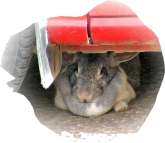 but a very large, white and
grey one which had clearly managed to avoid Sunday lunch. We saw the
rabbit on a few occasions after this, never in the garden, but I was
beginning to wonder if he would be attracted by lettuce and carrot
crops. Towards the end of March, as the weather warmed up, we
discovered him lying in the shade under the car. We chased him away
through the olive grove, but the next day he was back again. Since then
he returns whenever it is hot. On a few occasions I have driven the car
out of the drive and he just remains sitting there. Neighbours who
breed rabbits have all denied ownership, but I am suspicious that this
is because they don’t want the task of trying to catch him, or maybe he
has been released because he is at the end of his breeding life and is
too old to eat. Surprisingly he has not yet eaten anything in the
garden.
but a very large, white and
grey one which had clearly managed to avoid Sunday lunch. We saw the
rabbit on a few occasions after this, never in the garden, but I was
beginning to wonder if he would be attracted by lettuce and carrot
crops. Towards the end of March, as the weather warmed up, we
discovered him lying in the shade under the car. We chased him away
through the olive grove, but the next day he was back again. Since then
he returns whenever it is hot. On a few occasions I have driven the car
out of the drive and he just remains sitting there. Neighbours who
breed rabbits have all denied ownership, but I am suspicious that this
is because they don’t want the task of trying to catch him, or maybe he
has been released because he is at the end of his breeding life and is
too old to eat. Surprisingly he has not yet eaten anything in the
garden.
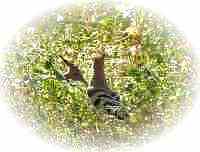 On March 8th, looking out of the kitchen window, I saw my
first Hoopoe of 2008. What unusual birds they are. As they fly from
tree to ground they look like giant moths with their broad wings. On
the ground they take on a completely different appearance with their
heads held high and their furled crests. Despite their visibility when
in the air, in trees or on the ground they can be very difficult to
spot, especially when only their heads can be seen above the vegetation!
On March 8th, looking out of the kitchen window, I saw my
first Hoopoe of 2008. What unusual birds they are. As they fly from
tree to ground they look like giant moths with their broad wings. On
the ground they take on a completely different appearance with their
heads held high and their furled crests. Despite their visibility when
in the air, in trees or on the ground they can be very difficult to
spot, especially when only their heads can be seen above the vegetation!
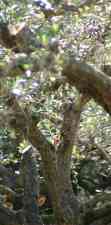 |
Spot the Hoopoes! |
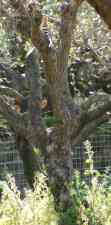 |
Around March 18th there appeared to be a considerable
increase in the aerial insect activity over the olive groves. Two days
later the first swallows appeared, feeding very actively. How do they
know?
 As we moved into April the migrants started arriving in numbers. The
first Woodchat of the year was perched on the telephone wires on April 2nd,
and then on April 5th a Collared Flycatcher perched almost
above my head in the olive tree beside the back door. He even stayed
quite close as I went indoors for my camera.
As we moved into April the migrants started arriving in numbers. The
first Woodchat of the year was perched on the telephone wires on April 2nd,
and then on April 5th a Collared Flycatcher perched almost
above my head in the olive tree beside the back door. He even stayed
quite close as I went indoors for my camera.
On April 17th birdwatcher Bob and I went for a walk around
Mithimna, hoping to see something interesting. Apart from a single
Little Egret on the beach, it was as if all the birds had disappeared.
The following day, sitting in my favourite spot outside the back door, I
saw a pair of Whinchats, a number of Spotted Flycatchers, Pied
Flycatchers and Swifts, and a pair of Tree Pippits. Such are the
vagaries of bird watching. Later in the day a number of Yellow Wagtails
passed through.
During a short walk near the house on April 25th I caught the
briefest of glances of a female Golden Oriole. A text message to Bob
elicited the reply that there was a small flock of them visible from his
balcony. I ran down there as fast as I could and was rewarded with the
best sighting I have ever had of Golden Orioles. It was about 7:30 p.m.
and they were beginning to settle down to roost in some tall trees.
What surprised me was that they were so visible in the trees. The next
evening I hid in the vegetation and managed to take some photographs.
“Yellow
is the colour of … “
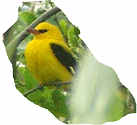 - April in Crete
- and golden birds!
- April in Crete
- and golden birds!
In the garden of the house
where we spent our first year in Crete there
were two large walnut trees. During that year – from April to April -
we saw the complete annual cycle from leaf emergence to fall, including
an excellent crop of nuts. A month or so after moving to this house I
was looking closely at the plants in our hanging baskets, and noticed –
in each basket - a plant I did not immediately recognise. On closer
inspection I realised they were small walnut saplings, about 8 inches
high, grown from walnuts which had dropped into the baskets. I managed
to remove them from the hanging baskets and re-pot them. They survived,
grew through the summer, dropped their leaves last Autumn, and now new
leaves are emerging. It may be a few years before they produce any
walnuts, but it will be interesting to see how much they grow each year.
It is difficult not to comment on the weather, especially as it has been
so varied during the last few weeks. As this is only our third April in
Crete, I cannot claim to have much experience of the Spring weather
patterns, but certainly this April has
 been much more windy than the
previous two. Most noticeable has been the proportion of hot Southerly
winds (“Gadaffi Winds”), producing a heat that you cannot escape from.
On Sunday, April 20th the wind was extremely hot and strong,
fanning the flames of the first forest fire of the year, up in the hills
behind us. Two days later, between 2 p.m. and 3 p.m., the temperature
shown on the thermometer outside the house dropped 13°, from 34°C to
21°C. It was like being moved from the oven to the fridge!
been much more windy than the
previous two. Most noticeable has been the proportion of hot Southerly
winds (“Gadaffi Winds”), producing a heat that you cannot escape from.
On Sunday, April 20th the wind was extremely hot and strong,
fanning the flames of the first forest fire of the year, up in the hills
behind us. Two days later, between 2 p.m. and 3 p.m., the temperature
shown on the thermometer outside the house dropped 13°, from 34°C to
21°C. It was like being moved from the oven to the fridge!
Click Picture to Enlarge
Google Earth™ users who are also birdwatchers will be familiar with the
site at 35°28’35.10” N, 23°55’59.72” E. Especially good during
migration, but whatever time of the year you are almost guaranteed to
see a Marsh Harrier. If you are VERY lucky (I have not yet been) you
may see an Osprey. The two tavernas there help make the trip even more
enjoyable.